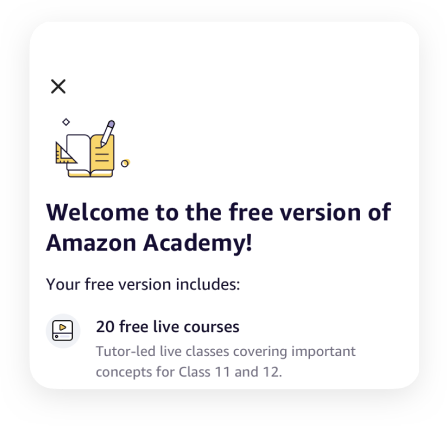
This was one of our biggest launches for Amazon Academy, as paid courses gave us the ability to provide higher quality teaching, yet in an affordable manner.
“I wanted an year long course, had read about AA, there were many options, but I found this to be better, trial was very important for me, 7 day policy was very good." – NPS survey testimonial
Teaching faculty is highly important for a student when enrolling in a course
Class 11 students look for full syllabus solutions, Class 12 students find revision material more relevant
Consisting of test, practice, videos, live lectures. No students were interested in pure test series.
Affordability and refund ability were a key attractions, students want to try the app without risk
"Need live lectures. Need premium lecture - give us something at nominal cost"
“Refunds is risk free - everybody’s grasping power is different - if somebody’s experience is bad, they will tell others also that don’t try. But with refunds there will be no regret."
Class 12 IIT Aspirants, user interview



Make decision-making process of payments as simple as possible for student
Leverage on existing payment systems from Amazon.in, reusing the payment interface and processes. Balance between an ideal simplified CX for the customer and operational feasibility based on A.in's payment processes
Affordability is key factor. Let students know they can trust our content quality and payment processes.
As 99% of our customers are on mobile
-min.png)

Main Considerations
1. Emphasise on live lectures, especially teaching faculty: Students expect to be able to choose and enrol into a batch with their preferred teachers and schedule.
2. Different grade, different needs: Target Year selection has to be accessible and visible


As compared to the upgrade CTA on the topbar, which only 2 clicked. This is contrary to our assumption that upsell ingresses will be primary way for students to be compelled to upgrade.

Only 3 out of 9 students read, but soon forgot what offerings was available.

Students was not aware if the pack was for their grade as well, unless prompted. Could potentially lead to mistakes.
Starter Pack was misunderstood to be a revision crash course.


As an overall design strategy, prioritise discovery of live courses and tests. Students are more inclined to explore paid offerings by enticing paid content preview (batch card in hero banner) or good free content

Packs are named as Standard Pack and Ultimate Pack. Relevant callouts for grade are also placed in subsequent flows, so that students will not lose sight of key pack details at any point in time
Ensure users have the right target year selected. Since target year is pre-selected in onboarding, more of a confirmation for first-time setting
Due to financial compliance requirements, our one-time payment for Ultimate Pack had to be split into 2 instalments. In this flow, I had to –
Another complexity to simplify was the lack of an immediate payment status, due to financial compliance requirements. Following after best practices from Amazon.in, I added a "payment processing" status, with directions to ensure students that know where to go next.

One of the challenges in designing a payments system is the breadth of use-cases and states. To ensure efficiency in implementation and consistency in user experience, I defined reusable components for the design system.
Since refunds are important to our customers, I made sure the designs would communicate this detail from the purchase flow to subscription management flow.
Subscription management
Renewal

Once again, this was one of our biggest launches for Amazon Academy, as paid courses gave us the ability to provide higher quality teaching, yet in an affordable manner. Numbers constantly indicate high satisfaction rate amongst our paid customers.
Our surveys amongst paid customers also point to the same.
“I wanted an year long course, had read about AA, there were many options, but I found this to be better, trial was very important for me, 7 day policy was very good."
Class 12 Aspirant, Paid customer outreach
However, despite high satisfaction rate amongst paid customers, conversion rate was low.
This was a multi-faceted problem beyond the payments experience, as we found out that we had low engagement for free customers, which is an important factor for conversion. According to our paid customer outreach, all 9 students indicated that interacting with a good live lecture in the first 10-15 minutes was what motivated them to purchase.
Upon deep-dive with data, we found that content discovery issues was likely preventing students from engaging with our content. Hence, we predicted that if students have an easier way to discover content, they will likely be more engaged and hence convert. This leads me to my next project –